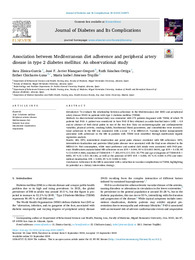Please use this identifier to cite or link to this item:
https://hdl.handle.net/11000/37448Full metadata record
| DC Field | Value | Language |
|---|---|---|
| dc.contributor.author | Zúnica García, Sara | - |
| dc.contributor.author | Blanquer Gregori, José Javier | - |
| dc.contributor.author | Sanchez-Ortiga, Ruth | - |
| dc.contributor.author | Chicharro-Luna, Esther | - |
| dc.contributor.author | Jiménez-Trujillo, Isabel | - |
| dc.contributor.other | Departamentos de la UMH::Ciencias del Comportamiento y salud | es_ES |
| dc.date.accessioned | 2025-09-22T11:29:55Z | - |
| dc.date.available | 2025-09-22T11:29:55Z | - |
| dc.date.created | 2024-11 | - |
| dc.identifier.citation | Journal of Diabetes and its Complications, Volume 38, Issue 11, November 2024, 108871 | es_ES |
| dc.identifier.issn | 1873-460X | - |
| dc.identifier.issn | 1056-8727 | - |
| dc.identifier.uri | https://hdl.handle.net/11000/37448 | - |
| dc.description.abstract | Introduction: To evaluate the relationship between adherence to the Mediterranean diet (MD) and periphereal artery disease (PAD) in patients with type 2 diabetes mellitus (T2DM). Methods: An observational sectional study was conducted with 174 patients diagnosed with T2DM, of which 78 patients had PAD. A patient was considered to have PAD if they obtained an ankle-brachial index (ABI) < 0.9 and/or absence of both distal pulses in one of the two feet. Data on sociodemographic and anthropometric variables, physical activity, smoking habits, biochemical blood parameters, and comorbidities were recorded. Good adherence to the MD was considered with a score ≥ 9 in MEDAS-14. Vascular factors independently associated with adherence to the MD in patients with T2DM were identified through multivariate logistic regression analysis. Results: ABI, DFU, intermittent claudication and pedal pulse absence correlated with MD adherence. DFU, intermittent claudication and posterior tibial pulse absence were associated with the final score obtained in the MEDAS-14. Nut consumption, white meat preference and saut´eed dish intake were associated with PAD presence. Multivariate analysis linked MD adherence to sex (OR = 0.044, 95 % CI 0.003–0619), age (OR = 0.139, 95 % CI 0.029–0.666), duration of T2DM (OR = 7.383, 95 % CI 1.523–35.779) and age at diagnosis of T2DM (OR = 6082, 95 % IC 1.415–26.136), as well as the presence of DFU (OR = 0.000, 95 % IC 0.000–0.370) and intermittent claudication (OR = 0.004, 95 % IC 0.000–0.534). Conclusions: Adherence to the MD is associated with a reduction in vascular complications in T2DM, highlighting its potential as a dietary intervention strategy. | es_ES |
| dc.format | application/pdf | es_ES |
| dc.format.extent | 7 | es_ES |
| dc.language.iso | eng | es_ES |
| dc.publisher | Elsevier | es_ES |
| dc.rights | info:eu-repo/semantics/openAccess | es_ES |
| dc.rights.uri | http://creativecommons.org/licenses/by-nc-nd/4.0/ | * |
| dc.subject | Type 2 diabetes mellitus | es_ES |
| dc.subject | Peripheral arterial disease | es_ES |
| dc.subject | Mediterranean diet | es_ES |
| dc.subject | Diabetic foot ulcer | es_ES |
| dc.subject | Intermittent claudication | es_ES |
| dc.subject | Amputation | es_ES |
| dc.subject.other | CDU::6 - Ciencias aplicadas::61 - Medicina | es_ES |
| dc.title | Association between Mediterranean diet adherence and peripheral artery disease in type 2 diabetes mellitus: An observational study | es_ES |
| dc.type | info:eu-repo/semantics/article | es_ES |
| dc.relation.publisherversion | https://doi.org/10.1016/j.jdiacomp.2024.108871 | es_ES |

View/Open:
Association between Mediterranean diet adherence and peripheral artery disease in type 2 diabetes mellitus An observational study.pdf
612,5 kB
Adobe PDF
Share:
.png)
